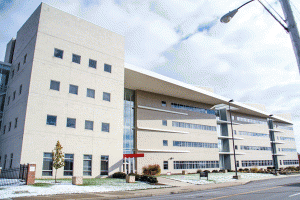
As part of a countrywide trend, Youngstown State University’s Beeghly College of Education has taken further steps this year, under Dean Charles Howell’s leadership, to combine the two required student field experience programs into a cohesive, yearlong one.
“Everything is changing about teaching,” Howell said. “There is a lot of pressure on teachers and there is performance pressure on schools and districts. So this is a hard environment to send kids into. We have done several things to make sure the kids are going to be more successful, one of these things is the yearlong clinical placement.”
Therese Kightlinger, the administrator of student field experiences in the Beeghly College of Education, said that their goal is to combine the separate programs of pre-clinical and student teaching, or clinical, by keeping students on the same site and in the same classroom yearlong.
“The yearlong experiences start with the pre-clinical placement, so it is the semester prior to student teaching, in which they are out in the schools with limited teaching responsibilities, supplemented by coursework focused on pedagogy. Then the following semester, they stay for their student teaching experience,” Kightlinger said.
Regina Rees, an YSU assistant professor of Literacy and Middle Childhood Education and the coordinator of the pre-clinical and clinical programs for Middle Education, said that the field experience program intensifies when students move into full student teaching.
“It [pre-clinical] isn’t quite so intense as the student teaching,” Rees said. “With student teaching, the YSU student takes over the whole classroom as time goes on.”
The purpose of this combination is multi-faceted and, according to Howell and Kightlinger, will yield an array of benefits for all parties involved.
“They [student teachers] see the movie, instead of the snapshot. The other thing they do is they see the evolving relationship between the students and the teacher,” Howell said. “You know I did my student teaching in the spring and I got there in January, and the teacher had lost control of her classes. I didn’t see what she did in order to lose them. It would have been very useful for me to have that yearlong placement”
Kightlinger said that during same site placement, student teachers witness students’ growth over an entire year, allowing them to better comprehend and plan for it.
“For the students, it is definitely looking at them getting the opportunity to see how a school year starts and how they close it, it is really getting started in understanding curriculum,” Kightlinger said. “They are able to see that impact on students, what that growth looks like and what the expectations look like throughout the entire year.”
Throughout the yearlong placement, parents and teachers watch the evolution of student teachers and develop dynamics with them. This permits parents’ and teachers’ time to better direct them in their progression, and, eventually, entrust them with more responsibilities. The program makes more extensive cooperative teaching possible.
School districts are also given the opportunity to observe student
teachers’ capabilities in a more thorough and intricate manner.
“The school gets a good long look at these people,” Howell said, “and then they hire a lot of them.”
Though this is an existing technique, Howell, after his arrival in July 2012, made yearlong placement programs a priority.
“One of the first things I did is I met with Connie Hathorn [Youngstown City Schools’ superintendent] and we discussed the need for well-prepared urban educators. I suggested this two semester placement as a way to accomplish this,” Howell said.
Through working with Austintown, Liberty, Campbell and Youngstown City Schools, Howell and his staff pinpointed classrooms where they could place students for an entire year. Then, they proceeded to seek out students who match up with the available slot.
“First of all, there has to be pre-clinical placement available at that site,” Howell said. “There has to be teachers available, there has to be the subject areas available, and obviously, nobody else has claimed that slot. There are a whole lot of variables; it is kind of a case-by-case decision whether we can make this type of extended placement. It is not just the characteristics; we aren’t just selecting specific people who would benefit from the experience. The challenge is do we have a slot available, will you fit in the slot?”
Rees said that in the beginning of the school year, she made this yearlong placement a priority with 75 percent of her middle school student teachers staying in the same location for both program.
“This year I made my business, I said, ‘I am only going to put them in schools where they could possibly stay,’ and just about everyone wants to stay,” Rees said. “We found fabulous teachers for them and they really are having a good experience there. They are crazy about the students there.”
